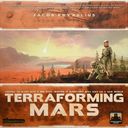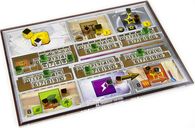Taming the red planet has started - Terraforming Mars Review
Terraforming Mars is an economically oriented board game that has been released at the end of last year by FryxGames. In the meanwhile, that game also received a Dutch translation thanks to the publisher Intrafin Games. We have been able to play this game at its release date back in may and by now we have been able to play the game multiple times so we can look back and let you know what we think of it.
Short overview
As the name probably suggests, this game will take place on the red planet, Mars. Every player takes the role of a corporation wanting to make the planet inhabitable by people. To accomplish this, there has to be oxygen on the planet, the temperature has to rise to a specific level and there have to be a number of oceans available to supply water. When all these conditions have been met, the planet is terraformed and the game has ended. The corporation that has collected the most points by having helped the terraforming the most, wins the game.
The components
The game is mainly played on a common board depicts the planet. The planet contains a grid that can be used by the players to build their cities, grow greeneries or create oceans by placing hexagonal tiles on them. Oceans can only be placed on their reserved blue spaces, no other tiles can be placed on these unless a project card specifically tells you to. Greeneries can be placed by exchanging the corresponding resources, but cities and ocean tiles can only be placed if a player has a tile that tells him to do so. We can also find the level of oxygen and the current temperature on the board, these are depicted by a big white cube on the corresponding gauge. On the outside of the board is a point track showing the Terraforming Score for every player, this track shows how good a player helped to terraform the planet and counts as the basis of the score for a player at the end of the game. Every time a player increases one of the terraforming values, this player also increases his terraforming score.
In addition to the common board, each player also has its own board to keep track of resources. The board shows the players resources in the form of cubes. There are three types of cubes: copper, silver and gold, these cubes are respectively worth 1, 5 and 10 to make it easy to keep track of bigger numbers. The tracks in the middle of the board show the production value for this resource, these are indicated by a cube in the color of the player. Resources are produced at the end of every round, and the production can be increased by playing certain project cards. At the top of the board we can find, from left to right: money, steel and titanium, and on the bottom: plants, energy, and heat. The player board is made of a thin reinforced sort of paper that the cubes slide of very easily, so watch out when reaching over the board because once the cubes have moved it is very hard to find their original position.
A third important part of the game is the project cards, these are probably the most important part of the game as they largely decide what actions you are going to take on your turn. There are three types of cards: blue cards give you an action or effect that you can use again on every turn, red cards are attack cards that allow you to steal or destroy resources from any other player and green cards give you a one time effect or action. The projects have a cost accompanied with them that has to be paid before you can complete them, this is the number in the upper left corner on the card. This price can be pretty high so it is recommended to make sure you don't have multiple other projects that have a better effect. Projects can also have conditions that have to be met before they can be played, mostly these depend on the terraforming values, certain amounts of oxygen, water or a certain temperature.
The effect a card has on the game is clearly displayed on the card using icons that match the resources, tiles or terraforming values. But if the icons aren't clear enough, every card also has a description of what exactly happens when it is played. On the bottom of the project cards, there is also a small quote about why a certain something changes. This quote is only to enhance the theme and does not have any effect on the game, but it adds this fun extra level to really feel like you are terraforming Mars.
Gameplay
The game is played in different rounds that in their turn are divided into different phases. Every round starts with the buying of projects, every player receives four project cards from the drawing pile and is allowed to buy as many of them as he or she wishes. Every project you want to buy costs the player 3M€ (Mars Euros). Don't forget! These projects have not been executed and still have to paid and all conditions have to be met to be able to play them.
The second phase is the action phase, now players get the chance to execute as many actions as their resources and project cards allow them to at that moment. Actions can be various things like playing a project card, create greeneries or let the temperature on the planet rise using the heat on your player board. However, each player can only do two actions at a time, after these two actions its the turn of the next player and so on, when it's your turn again, you can again do up to two actions. This will continue like this until every player has passed.
After everyone has done all his actions, the production phase starts. Now, everyone will receive a number resources indicated by the production counter for that resource on their player boards. The production for money is a bit special as this is the current terraforming score on the main board plus the production value on the player board. The first player marker is being passed to the next player and a new round starts.
When in a round and all terraforming conditions are satisfied, the current round will still be finished so all players have time to complete their projects and score as many points as possible.
Terraforming Mars Gameplay
Our opinion and conclusion
In the meantime I have been able to play Terraforming Mars about five times and not a single game was like one of the previous games, this is mostly because of the amount and the order of the project cards, in the first few rounds these can limit the available options on your turn drasticly. The actions on the cards have a good balance relative to their cost, so its not possible for a player to immediately increase the production of resources to the highest amount without sacrifising other things. The cards are als very different from each other, yet the endings scores are always very close for all players.
The manual states that a game takes around 60 to 120 minutes, but in our experience this will take a little longer depending on how long players have to think about what project to execute. For our group a game usually took about 2 to 3 hours what might be a long game for some players, but we didn't think this was a problem. There is also little down time as each player can only take two actions sequentially.
Apart from the player board, the game has really great components in our opinion. It has happened that a player hit his own player board during the game while playing a card or placing a tile. The cubes on your player board might move and it's pretty hard to find their last place if you don't keep track of your production value. The game might have had player boards with small holes to hold the cubes in place.
I'm still very happy when someone asks me to play Terraforming Mars and I will propose this game when asked to choose, you only need some time to play. For me this is one of the great games this year, I will probably be playing it a lot the next months. I would realy recommend this if you have a chance to play.
Final judgment
Posted on 12 Jul 2017 by Jerodev





